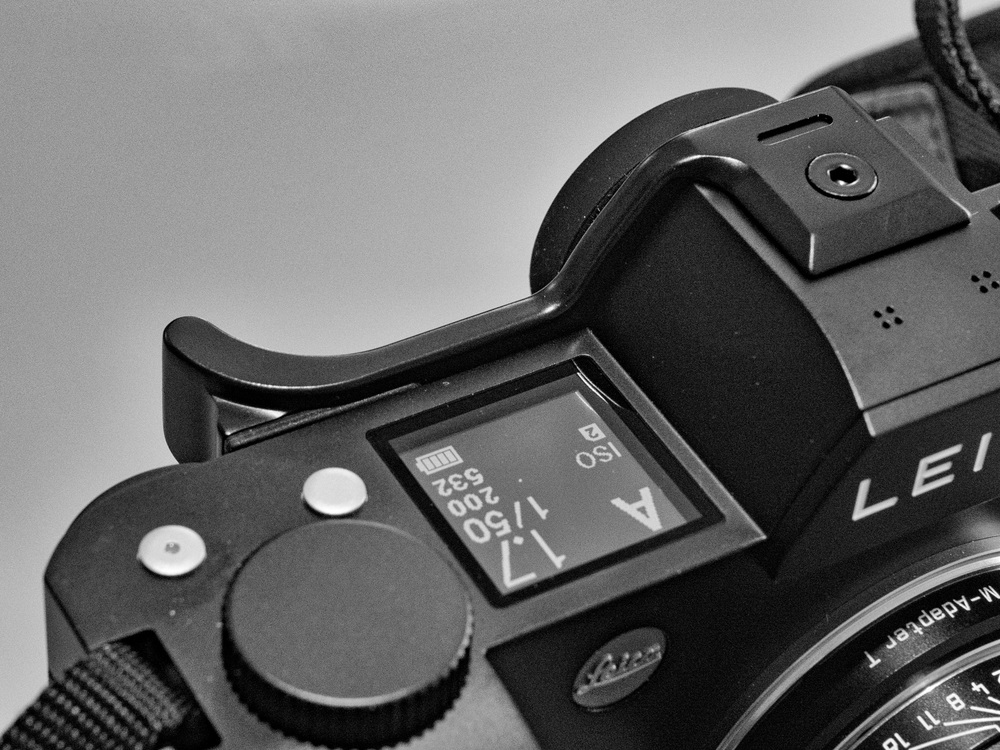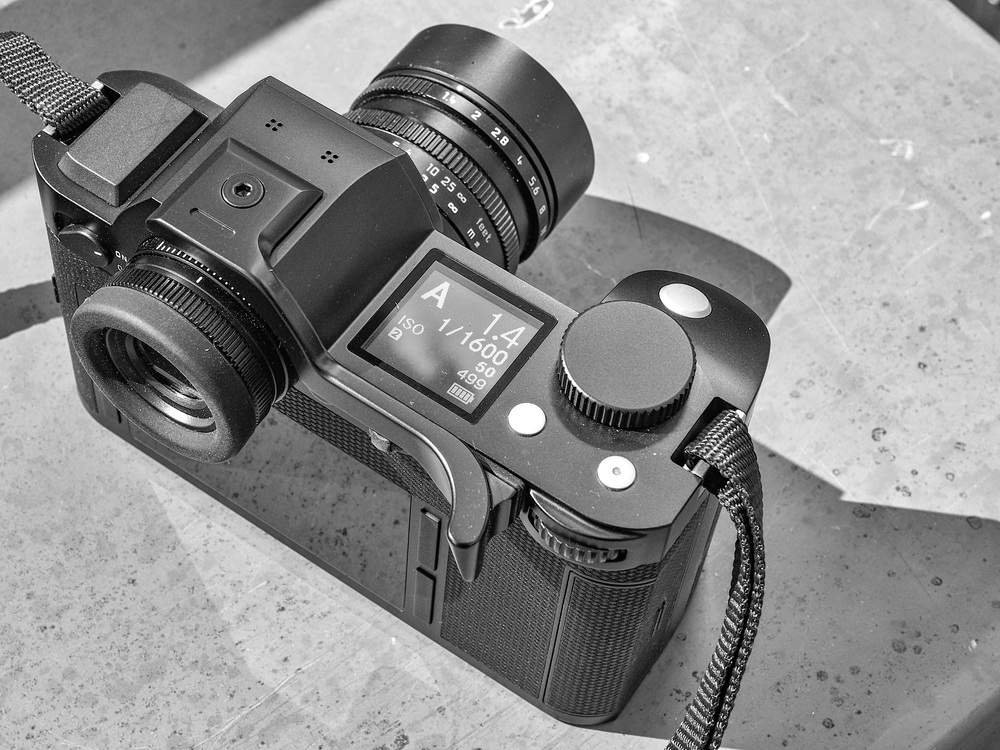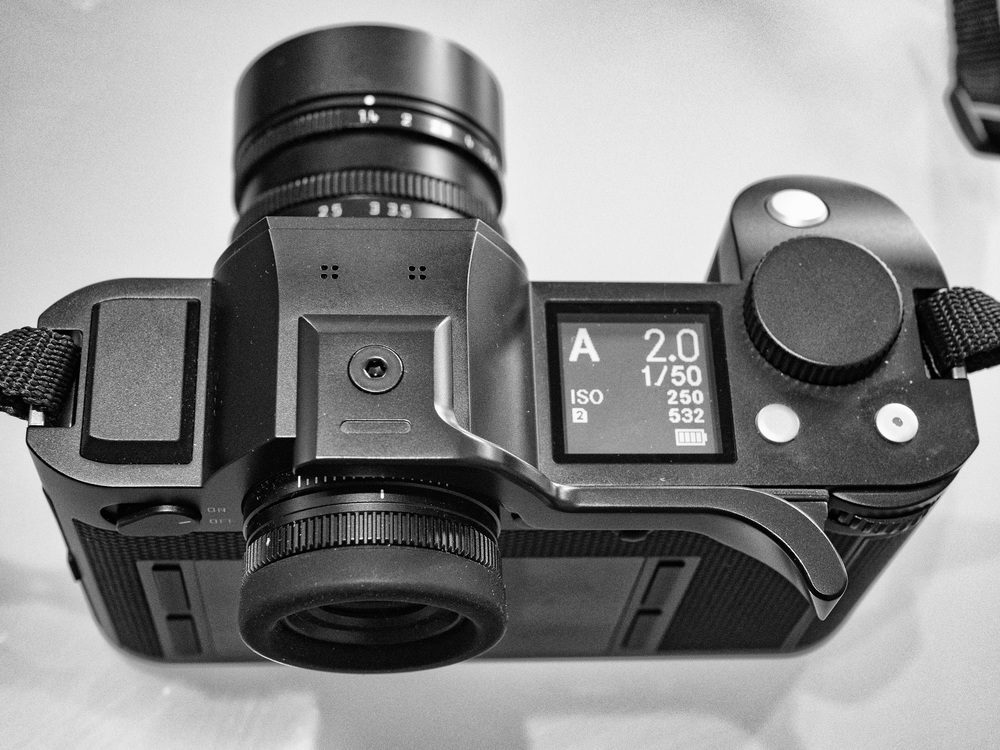Tim Isaac at Matchtechnical in Seattle has rolled out the big guns in designing his Thumbs Up for the Leica SL. It’s a whopper. Put it next to an equivalent grip for the M and the new brass grip is a real biggie.
Beautifully crafted, as always, this Thumbs Up uses a swan-neck design to anchor on the accessory shoe, perched atop the viewfinder, and swoop down to the traditional position at the top of the camera back. Unlike M grips, this one comes with an allen key so it can be tightened in place. Perhaps this is no bad thing in view of the size of the rig.
Tim has clearly out a lot of thought into the requirements of SL, a heavier camera than the usual Thumbs Up fare. As he says:
One of my goals was to make the Leica SL, in particular with that lens [24-90], more manageable with one hand. After a few minutes for me, my grasp of the camera would start to shake if I held the camera with one hand. Therefore the thumb rest portion is larger than on other models of Thumbs Up to better distribute the load. My goal was an improved balance with better balance even with one hand.
In use, the grip feels very much like the ones we are familiar with for other Leica cameras. The thumb section is larger, as befits the overall construction, and it works really well in combination with the SL’s substantial front grip. The camera feels much more solid in the hands and, with the 24-90mm mounted, it is definitely more wieldy. The grip section is raised above the camera top plate by a few millimetres to allow the bottom section to avoid the joystick and viewfinder button (see the picture at the top of this article).
I took it out for the day with two lenses, the 50mm Summilux-M and the 24-90mm zoom. It’s an asset even with the M lens, making the camera feel more solid. With the large zoom it is almost essential, such is the difference it makes. As with the M designs, the thumb has to be lifted from the curved grip to operate the thumbwheel. Some may not like this but I find it no problem, even on the SL where the grip section is much larger.
With the chunky front grip and the Thumbs Up combined, the camera can be held safely in one hand and is comfortable to carry even when using a wrist strap. If a neck strap is worn the extended viewfinder eyecup combines with the grip to ensure the camera doesn’t feel uncomfortable against the chest. With the M thumb grip, for instance, the curved grip tends to prod the chest.
Unlike previous Thumbs Up grips I have tried on various cameras, this model has a top plate to cover the accessory shoe. The plate is chamfered and complements the design of the camera. However, since it is secured by a screw, using flash or other shoe accessories will involve a bit of work with the supplied allen key.
I have just one reservation about handling the SL with the new Thumbs Up. The depth of the SL’s front grip means that the right hand is rather stretched when the thumb is nestled against the curve of the rear grip. My hands are medium sized and I am just about on the limit. Owners with smaller hands should check out the grip before buying.
Tim’s grips, made from brass and painted (in this case) black, are works of art. They brass quite easily and I have an M version, now sitting on the M-D, that has worn one nicely, just like an old pair of Levis. While the SL won’t brass, this lovely grip will. Can’t wait.
Despite the rather hefty price tag of £175, this is one accessory that you really need for your SL. Once you’ve tried it you have to buy it.
The Thumbs Up SL grip is available from Red Dot Cameras in London’s Old Street.
- Subscribe to Macfilos for free updates on articles as they are published. Read more here
- Want to make a comment on this article but having problems? Please read this
- Product shots by Mike Evans with the Olympus PEN-F and 25mm Leica DG Summilux




Thanks Tim
I am speaking personally, of course. I can fully understand that others might want to use a Thumbs Up.
The ergonomic piece on the DSLRs and CSCs can be good, I agree, but I had no problems before they appeared. With the M240 family there is a little shaped piece near the thumbwheel. I have issues with the M240 family thumbwheel which relates to having to press the button at the front to perform certain functions, but the little shaped piece is quite nice, particularly when used in conjunction with a good half case.
I first started using the M8 when I was living in Qatar. In that part of the world it is very humid for at least four months of the year. Often the whole camera and all lenses would steam up when exposed to the heat and you would have to wait until they had de-misted, so to speak, before using them. I had no problem about holding my M8 during the humid season. Indeed, I found its compact size to be a blessed relief after using large Nikon DSLRs.
I have many screw mount Leicas and I have never felt the need for any extra grips. Indeed, unlike the Ms, the LTM models actually feel more secure when they are not in an ever ready case. Their size and shape makes them very easy to grip.
Moving on to what I believe is the source of the use of the Thumbs Up, film Ms; I can see with my double stroke M3 that you might want to put your thumb between the wind on lever and the camera body to determine whether the camera is wound on. I have tried this, but I always find it disconcerting and unsettling (unstable, if you wish) when the lever goes loose after firing the shutter, so I don’t do this. I have also tried this with the single stroke Ms (I have most of the models from M3 up to M7) and I find the same disconcerting feeling after the shutter is released.
I have rather small hands and I find that my thumb is more likely to be at an angle rather than vertical when holding an M camera. I also find that my thumb just about reaches over the top plate This is a much more comfortable grip for me. I can understand, of course, that for people with larger hands, a place to put your thumb might be a definite asset. The other issue is, of course, giving up the cold/hot shoe which can have other uses.
I wish you all the best with your business. Thank you for your kind offer but, if I find that I need one, I would be quite happy to pay you the going rate for the Thumbs Up.
Best Wishes
William
Greetings Mr. Fagan,
It appears you have provided small opening for my reply. Thank you for your two questions.
On the first day using my M8 in 2007, I found that after some short time holding it, the camera would begin to slip ever so slightly from the grip of my right hand. My initial solution was simple; grip the camera with more force! This initial experience took place in the warm and humid environment on the streets of Hong Kong. After 30 minutes or so, I found that my hold on the camera now included a bit of a tremble unless I supported the camera with my left hand. When shooting on the street, I prefer to use one hand to be more discrete. My M6 did not slip in my hand. Of course, I was using the film advance lever as a thumb rest as you mentioned. The film advance lever was not actually designed for that purpose, but it worked perfectly for many of us. This lever was clearly missing on the M8 and there was an entirely new feeling when holding, composing and shooting with the missing film advance lever.
I set about to design some means of improving my grip on the M8.
Mr. Fagan, you can read the thread I began in May 2007 describing the Thumbs Up design and prototyping. With 43,000 reads of this thread, it seemed I had the attention of a large and interested following.
http://www.rangefinderforum.com/forums/showthread.php?t=41649
My first Thumbs Up was modeled on my CAD software. I then set about producing one. The first was made from laminations of thick paper held together with white glue. It worked surprisingly well. No 3D printers in 2007! By redirected the gripping force into a simpler force that resolved itself by allowing my thumb to counteract the twisting moment of the camera, I could nearly eliminate the gripping pressure. Stated another way, the weight of the camera tries to hang from your hand rather than squeezing the camera into submission. The result is that you no longer have to squeeze at all. Your right hand remains relaxed and this in turn reduces camera shake caused by gripping pressures.
Your thumb, Mr. Fagan, loose or not, seeks some common spot on the back of the camera during composing and shooting. By using a Thumbs Up, you will find that your thumb has a consistent position which serves to standardize your grip. This easily repeatable position means you will find a more natural grip that falls into place automatically. By reducing the time we spend setting up for a shot, and by reducing gripping pressure and camera shake the resulting shot is improved.
The reason you see such remarkable ergonomic shapes on DSLR cameras is to provide the same natural low pressure grip on the camera. Some of these cameras have considerable weight and the less gripping pressure the better. The right hand in a natural position with force distributed over a larger area reduces fatigue and camera shake.
The remarkably talented design engineers at Leica have sought to keep the shape of the M series cameras consistent with their heritage. I try my best to complement their efforts with the lines and shapes that result in the Thumbs Up.
Mr. Fagan, let me offer a Thumbs Up of your choice to fit any one of your Leica cameras at no charge. In exchange, I would enjoy reading your impressions here.
Here is wishing you some good light and great shooting,
Tim Isaac
Match Technical
I can’t see the point of a Thumbs Up and would never want to use one. I don’t find that I have loose thumb sticking up and looking for a resting place when I am shooting with a Leica.
What are its origins? Perhaps, putting your thumb behind the wind on lever of a Double Stroke M3 to ensure that it is fully wound on?
I have never seen one on an SLR and the association largely relates to Leicas. Modern DSLRs do sometimes have a little grip moulding at the top right at the back, however.
William